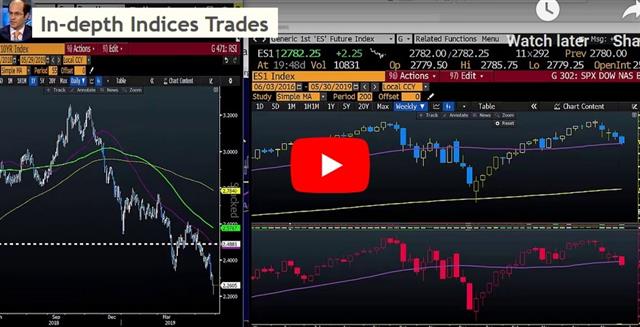US and global yield curves are at aspot with dangerous implications, but many may argue that doesn't matter because economic data is solid. We will explain why that's a poor argument. The US dollar is firm across with the exception against the loonie. The revised US Q1 GDP report is due next (see more below). The latest Premium video is more extensive than usual due to the situation with indices. Full video below.
Before a late session recovery on Wednesday, US yields had fallen 5-6 basis points across the curve. The 10-year yield fell as low as 2.20% and the 5-year to 2.00%. That compares to three-month bills at 3.38% and the lower band of Fed funds at 2.25%.
It's a similar story elsewhere including in Canada where the BOC was surprisingly upbeat about the domestic economy after holding overnight rates at 1.75% despite the 10-year at 1.58%.The take from the BOC is typical of those who are arguing against the signals from the yield curve. They say the data is strong.
They're correct but the lesson of the yield curve posits that the data is almost always strong when it inverts. It's a signal that occurs ahead of the turn, so by definition it needs to emerge before the data turns. It's also the reason that central banks almost always resist cutting.
The March 2007 Example
For example, the peak of the US curve inversion prior to the financial crisis was in March 2007 when 3m bills fell as much as 71bps below the 10-year. In that month, non-farm payrolls rose 152K, which was slightly above the 12-month average of 146K. The ISM non-manufacturing index was at a healthy 54.3. The retail sales control group had risen 0.9% and had only posted a single negative print in 18 months. Consumer confidence was near a six-year high. A year later the economy was in shambles.
Which yield curves matter? Ashraf will post a detailed chart of the relevant yield curve measures using yield spreads for 10-2 year, 3-5 year and 3-month to 10 year.
As always, the timing is the difficult part. The S&P 500 and yen crosses peaked long after the yield curve inversion so it's a signal that argues for caution, not immediate action.
What would confirm it is a slowdown in data or a further intensification of the trade war. The second look at Q1 GDP is due next and expected to be trimmed to 3.0% from 3.2%. What will be more important are signals about Q2 GDP; JPMorgan cut its estimate to just 0.6% earlier this week.
Another data point to watch is the April US advance goods trade balance report for signs of trouble from the trade war. The consensus is a rise in the deficit to $72.5B from $71.4B.
Trading foreign exchange on margin carries a high level of risk and may not be suitable for all investors. The high degree of leverage can work against you as well as for you. Before deciding to trade foreign exchange you should carefully consider your investment objectives, level of experience and risk appetite. The possibility exists that you could sustain a loss of some or all of your initial investment and therefore you should not invest money that you cannot afford to lose. You should be aware of all the risks associated with foreign exchange trading and seek advice from an independent financial advisor if you have any doubts.
Recommended Content
Editors’ Picks

EUR/USD consolidates weekly gains above 1.1150
EUR/USD moves up and down in a narrow channel slightly above 1.1150 on Friday. In the absence of high-tier macroeconomic data releases, comments from central bank officials and the risk mood could drive the pair's action heading into the weekend.

GBP/USD stabilizes near 1.3300, looks to post strong weekly gains
GBP/USD trades modestly higher on the day near 1.3300, supported by the upbeat UK Retail Sales data for August. The pair remains on track to end the week, which featured Fed and BoE policy decisions, with strong gains.

Gold extends rally to new record-high above $2,610
Gold (XAU/USD) preserves its bullish momentum and trades at a new all-time high above $2,610 on Friday. Heightened expectations that global central banks will follow the Fed in easing policy and slashing rates lift XAU/USD.

Pepe price forecast: Eyes for 30% rally
Pepe’s price broke and closed above the descending trendline on Thursday, eyeing for a rally. On-chain data hints at a bullish move as PEPE’s dormant wallets are active, and the long-to-short ratio is above one.

Bank of Japan set to keep rates on hold after July’s hike shocked markets
The Bank of Japan is expected to keep its short-term interest rate target between 0.15% and 0.25% on Friday, following the conclusion of its two-day monetary policy review. The decision is set to be announced during the early Asian session.

Moneta Markets review 2024: All you need to know
VERIFIED In this review, the FXStreet team provides an independent and thorough analysis based on direct testing and real experiences with Moneta Markets – an excellent broker for novice to intermediate forex traders who want to broaden their knowledge base.
